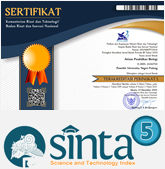The Identification of Levels of Concept Understanding Using Three-Tier Multiple Choice Diagnostic Test
Abstract
This research aims at identifiying the levels of concept understanding on virus material at class X, SMA Pertiwi 1 Padang. This is a descriptive research involved 138 students from class X, SMA Pertiwi 1 Padang. This research used Three-Tier Multiple Choice diagnostic test instrument which categorized into three question levels. The results showed that students experienced the highest level of concept understanding on prevented virus infections with 53,87%, then followed with the highest level of full misconception on the role of the beneficial virus with 36,23%, the highest level of misconception false positive on the different virus and bactery with 12,32%, the highest level of misconception false negative on virus living with 14,49%, the highest level of guessing on virus’ classification with 7,61%, and the highest level of ununderstandable of virus replication’s cycles with 52,18%. Most of students experienced low criteria of the concept material of virus with 34,38%.
Keywords
Full Text:
FullpaperReferences
Alamsyah, M. 2017. Analisis Kesulitan Pemahaman Konsep Matematika Dasar Pada Siswa Kelas VIII MTsN Balang-Balang. Skripsi. UIN Alauddin Makassar.
Andriyani, N.F., Prihandono, T., & Maryani. 2017. Identifikasi Pemahaman Konsep Siswa Kelas XII Pada Materi Pokok Gelombang Cahaya di SMA. Seminar Nasional Pendidikan Fisika 2017, 2, 1 – 5.
Ariska, M. 2015. Studi Pemahaman Konsep Siswa Pada Sub Konsep Rangkaian Listrik Arus Searah di Kelas XI SMA Negeri 1 Palembang. Jurnal Inovasi dan Penbelajaran Fisika, 2, 147 – 154.
Astari, R. D. 2012. Three-Tier Test. Instrumen Identifikasi Miskonsepsi Konsep Atom, Ion, dan Molekul. Yogyakarta: UIN Sunan Kalijaga.
Caleon, I. & Subramaniam, R. 2009. Development and Application of a Three-Tier Diagnostic Test to Assess Secondary Students’ Understanding of Waves. International Journal of Science Education, 32, 939 – 961.
Delvionna, A. 2018. Analisis Pemahaman Konsep Peserta Didik Kelas VIII SMP Negeri 34 Padang Pada Materi Sistem Peredaran Darah Menggunakan Tes Diagnostik Two Tier Multiple Choice. Skripsi. Universitas Negeri Padang.
Fakhrah, M. & Sarong, M. A. 2014. Peningkatan Pemahaman Konsep Siswa Materi Pengklasifikasian Phylum Arthropoda Melalui Model Pembelajaran Langsung (Direct Instruction). Jurnal Biotik, 2, 77 – 137.
Istiyani, R., Muchyidin, A. & Rahardjo, H. 2018. Analisis Miskonsepsi Siswa pada Konsep Geometri menggunakan Three-Tier Diagnostic Test. Cakrawala Pendidikan, 2, 223 – 236.
Lestari, E. 2015. Identifikasi Miskonsepsi Pada Konsep Virus Dengan Menggunakan Three-Tier Test. Skripsi. Jakarta: UIN Syarif Hidayatullah.
Maulini, S., Kurniawan, Y., & Muliyani, R. 2016. Three-Tier Test untuk Mengungkap Kuantitas Peserta didik yang Miskonsepsi Pada Gaya Pegas. Jurnal Ilmu Pendidikan Fisika, 2, 42 – 44.
Mustika, A. A., Hala, Y., & Arsal, A. F. 2014. Identifikasi Miskonsepsi Mahasiswa Biologi Universitas Negeri Makassar pada Konsep Genetika dengan Metode CRI. Jurnal Sainsmat, 3, 122 – 129.
Pesman, H. & Eryilmaz, A. 2010. Development of a Three-Tier Test to Assess Misconceptions About Simple Electric Circuit. The Journal of Education Research, 103, 208 – 222.
Sudarisman, S. 2015. Memahami Hakikat dan Karakteristik Pembelajaran Biologi dalam Upaya Menjawab Tantangan Abad 21 Serta Optimalisasi Implementasi Kurikulum 2013. Jurnal Florea, 2, 29 – 35.
Suparno, P. 2005. Miskonsepsi dan Perubahan Konsep dalam Pendidikan Fisika. Jakarta: PT. Grasindo.
Syahrul, D. A. & Setyarsih, W. 2015. Identifikasi Miskonsepsi dan Penyebab Miskonsepsi Siswa dengan Three-Tier Diagnostic Test Pada Materi Dinamika Rotasi. Jurnal Inovasi Pendidikan Fisika (JIPF), 4, 67 – 70.
Tendrita, M., Safilu & Parakkasi. 2016. Peningkatan Aktivitas Belajar dan Pemahaman Konsep Biologi dengan Strategi Survey, Question, Read, Recite, Review (SQ3R) Pada Siswa Kelas XI IPA 2 SMA Negeri 5 Kendari. Varia Pendidikan, 28, 213 – 224.
Yogica, R. 2014. Efektifitas Modul Bergambar Disertai LKS Berorientasi Konstruktivistik Terhadap Proses dan Aktivitas Belajar Siswa Dalam Pembelajaran Biologi SMA. Jurnal Penelitian Pendidikan, 5, 65 – 73.
DOI: http://dx.doi.org/10.24036/apb.v4i2.5638
DOI (Fullpaper): http://dx.doi.org/10.24036/apb.v4i2.5638.g2953




